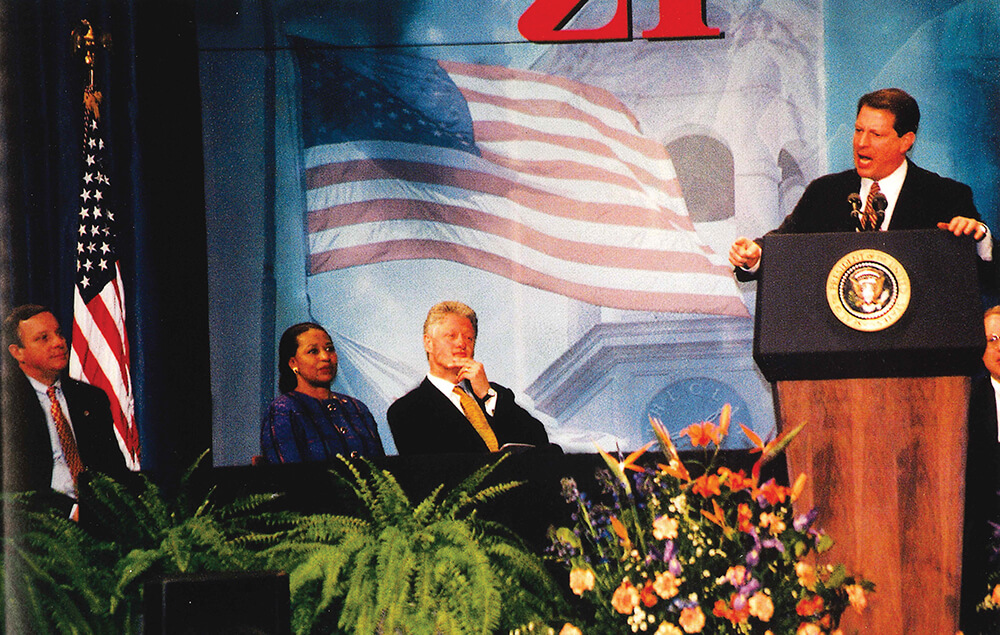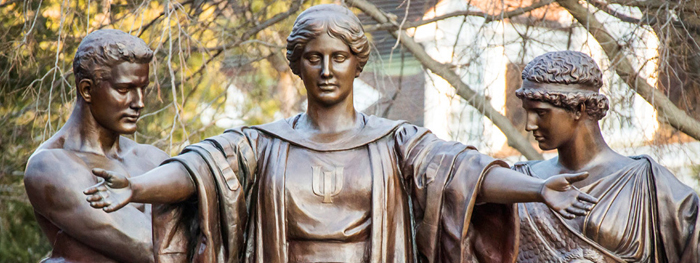Memory Lane: The Comeback Kid
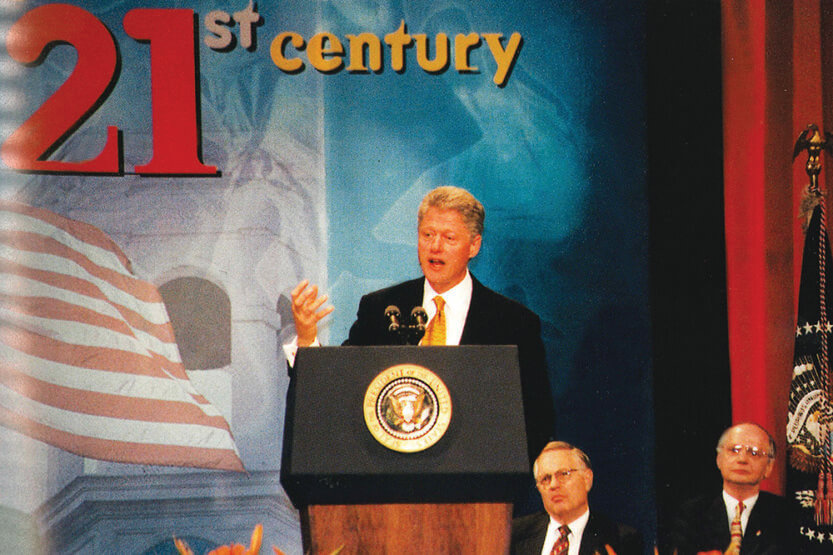 President Clinton speaks at the Assembly Hall (Image courtesy of Illini Media)
President Clinton speaks at the Assembly Hall (Image courtesy of Illini Media) It was one of the defining moments of the 1990s—William Jefferson Clinton, President of the United States, standing in front of television cameras at the White House and telling the
public lie that would mar his legacy: “I did not have sexual relations with that woman, Miss Lewinsky.”
That happened on Jan. 26, 1998. On Jan. 27, he gave the annual State of the Union address to Congress. And on Jan. 28, he boarded Air Force One for a flight from Washington to Champaign’s Willard Airport to deliver a speech at the U of I—a rare visit to a college campus by a sitting president.
Clinton’s stop in Champaign was the first of two planned visits that day—the second was in La Crosse, Wis.—meant to reinforce the talking points from his State of the Union address and to gauge voters’ responses to his ideas. He chose to speak at Illinois as recognition for its technological breakthroughs related to computing and the internet—one of the key themes of his national address.
Given the timing, the visit also would gauge voters’ reactions to Clinton’s emerging sex scandal, only a week after allegations surfaced that he had had an affair with White House intern Monica Lewinsky and then urged her to lie about it to federal prosecutors.
Despite the scandal, Clinton’s team felt optimistic about his trip to Champaign. Demand for tickets to his speech had far exceeded Assembly Hall’s capacity, and local news coverage in the days leading up to the event made it clear that many voters—ones who had been interviewed, at least—were on his side.
His team’s optimism turned out to be justified.
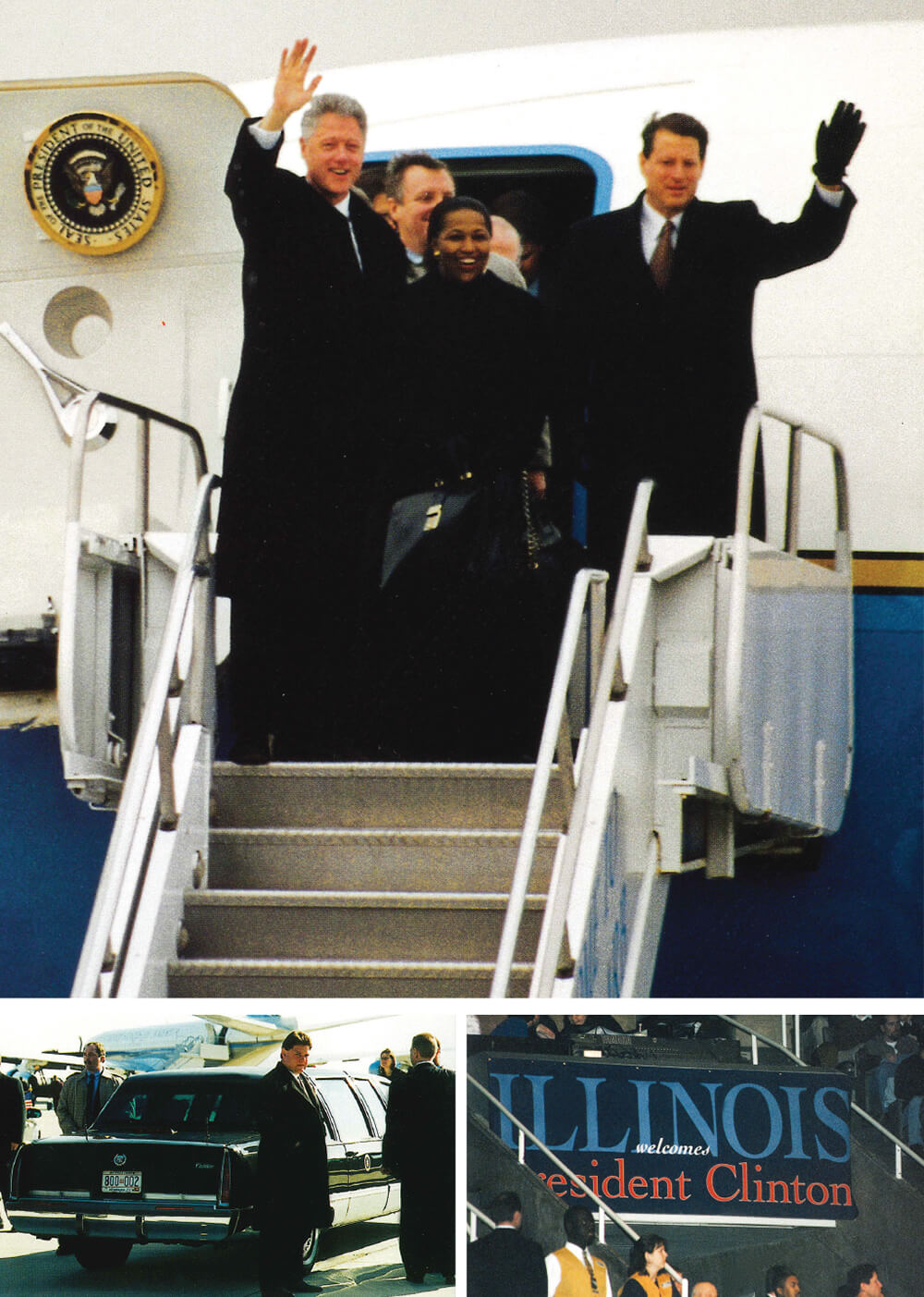
Clockwise from the top: The presidential entourage greets the media; Assembly Hall signage and the Secret Service guards Clinton’s limo. (Images courtesy of Illini Media)
From the time he landed at Willard Airport shortly before 10 a.m. until the time he departed that afternoon, Clinton encountered receptive crowds everywhere he went, according to Daily Illini reporters who covered the visit, among them Brian Costello, ’98 MEDIA; Michael Dizon,’94 BUS, ’95 BUS, MBA ’98, MA ’98 MEDIA; Michelle Brutlag Hosick, ’98 LAS; David Klepper, ’99 LAS; and Michele Steele, ’00 LAS.
As the presidential motorcade traveled from the airport to the Assembly Hall, Clinton passed thousands of waving, cheering people lining the streets, including drivers who abandoned their cars and a farmer who took a break from his idling tractor to survey the scene.
Things only got better for Clinton from there. Outside the arena, he found an excited, pythonic line of ticketholders, stretching through the parking lot and wrapping all the way around its perimeter. Many held orange-and-blue signs, with positive messages such as “America’s Heartland Welcomes President Clinton,” “Tipper [Gore] is Tops” and “Bill Rocks!” Some had been there braving the cold since 4 a.m. and were eager to go in and soak up the presidential glow (and the heat).
When the audience finally got inside the Assembly Hall, they found themselves in a festive atmosphere that was almost like a Big Ten basketball game and a rock concert rolled into one.
The opening acts included campus music groups such as the Black Chorus and speakers like Vice President Al Gore.
Gore, looking ahead to his own presidential run, gave a “rousing and barnstorming” speech that credited the U of I’s innovations in science and engineering with helping to “create the future.”
But Clinton was the main event, and the Illinois pep band played “Hail to the Chief” as he took his place behind the presidential podium, his backdrop a giant red-white-and-blue banner that announced, “Preparing America for the 21st Century.”
Managing to be both direct and laid-back, Clinton spoke about education, science and technology, climate change and Social Security—hewing closely to his State of the Union address. One exception was his focus on the U of I’s role in popularizing the internet, by developing the Mosaic web browser and Telnet email application. Illinois has “led our way into the Information Age,” the president said.
As for the elephant in the room: the scandal that would soon threaten his administration? Clinton and Gore omitted it entirely to the 300 members of the international press who had shown up—knives out, beaks bloody—and turned the visit into a media extravaganza.Their avoidance was as good as a confession.
But for many audience members, the omission didn’t seem to matter. It was what Clinton and Gore did say that made an impression—and the way they said it.
Indeed, the crowd of 12,000 students, faculty, staff and community members responded throughout their speeches with “cheers, applause and standing ovations,” according to The Daily Illini.
“The relatable way they both spoke and the energy in the air were unforgettable,” says Brittany Wilson, ’01 LAS, MBA ’12. “I have never seen or experienced anything else like it.”
That was the experience of those who actually managed to get into the Assembly Hall.
Thousands of others, like Molly Mannancheril, ’01 LAS, had a totally different experience. After standing in that long line outside the arena and missing out on seats, she settled for one of the overflow rooms at the Intramural Physical Education Building (IMPE), a couple blocks away. There, more than 8,500 people watched the event on closed-circuit televisions and, later, got to see Clinton and Gore in person. It wasn’t what they had expected but it was still “super fun,” says Mannancheril, “and we shook their hands!”
Following the short visit at IMPE, a crowd of thousands lined Peabody Avenue to watch the motorcade drive away, including many students from their dorm-room windows in the “Six-Pack,” their faces pressed against the freezing glass, like children viewing Christmas lights from the backseat of their parents’ car.
Heading back to Willard Airport, President Clinton and his staff felt like their trip to Champaign had been a huge success, a clear win in a week of losses.
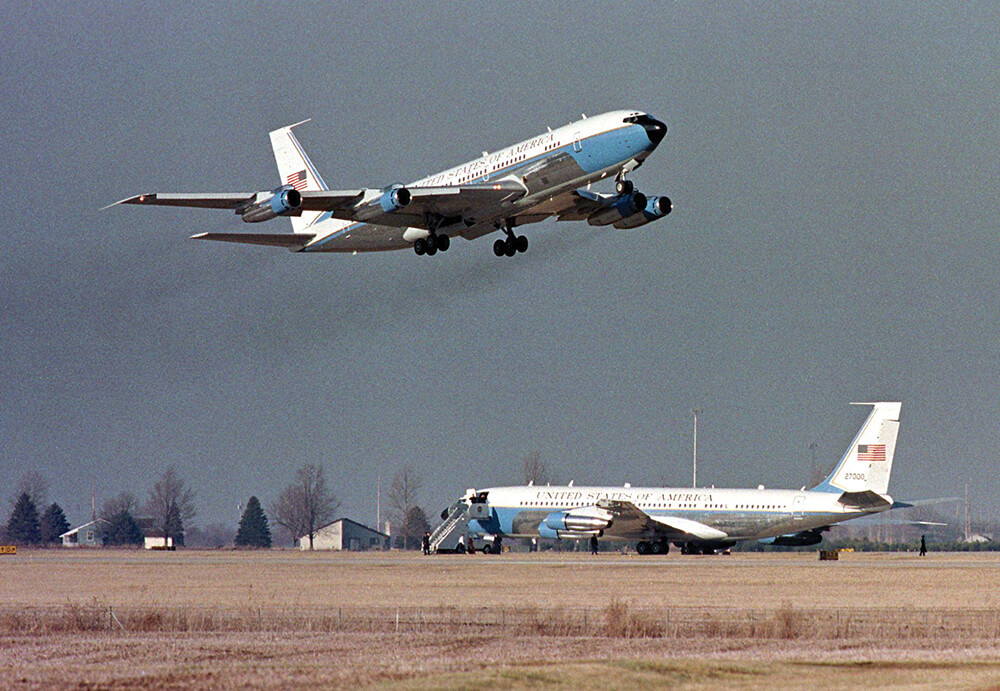
After Air Force One got stuck in the mud at Champaign’s Willard Airport, officials had to call in the backup plane. It was the first, and only, time a president has needed to use the backup. In Clinton’s case, it was the same aircraft that transported JFK’s body from Dallas to Washington, D.C., in 1963. (Image by Vincent LaForet/Getty Images)
Minutes later, the presidential limousine arrived on the tarmac, where Clinton found the press waiting for him, ready to report on the visit’s final moments.
The president exited the car, obviously in good spirits, and boarded Air Force One for his flight to Wisconsin.
And then, in a cosmic joke of jet-sized proportions, the plane got stuck in the mud.
Like, really stuck.
“As it taxied away, it came to an abrupt halt,” recalls Andrew Ryback, ’99 LAS, who was there on assignment for the Illio yearbook. “One of the main gears ended up off the runway,” he says, and that was that. The pilot revved the engine, to try to force the wheel back onto the pavement, but it only made the problem worse, digging the wheel deeper and deeper into the mud.
“It was by far the most thrilling part of the day!” Ryback says, laughing. Twenty-five years later, it’s the detail that most alumni recalled in our reporting for this story.
Of course, given the media spotlight on Clinton’s visit, the gaffe became international news.
“I was living in the farmhouse next to the airport runway,” says Lisa Innes, ’90 ED, “when CNN and Fox News came and parked in my front yard so they could get a bird’s eye view of the situation!”
Ultimately, the White House had to fly in the backup Air Force One to get Clinton to Wisconsin on time.
According to Clinton’s spokesperson, the president and his staff spent their 70-minute layover aboard the stranded plane, playing a spirited game of hearts.
Some reporters remained on the scene, as crews worked until 1 a.m. to free the aircraft from the mud, after which it had flown back to Washington, D.C.
With that, the U of I’s weird and wild presidential visit was officially over.
But for William Jefferson Clinton, sitting on the errant plane that afternoon, keeping his cards close to his vest—his time of being stuck in the mud was just getting started.
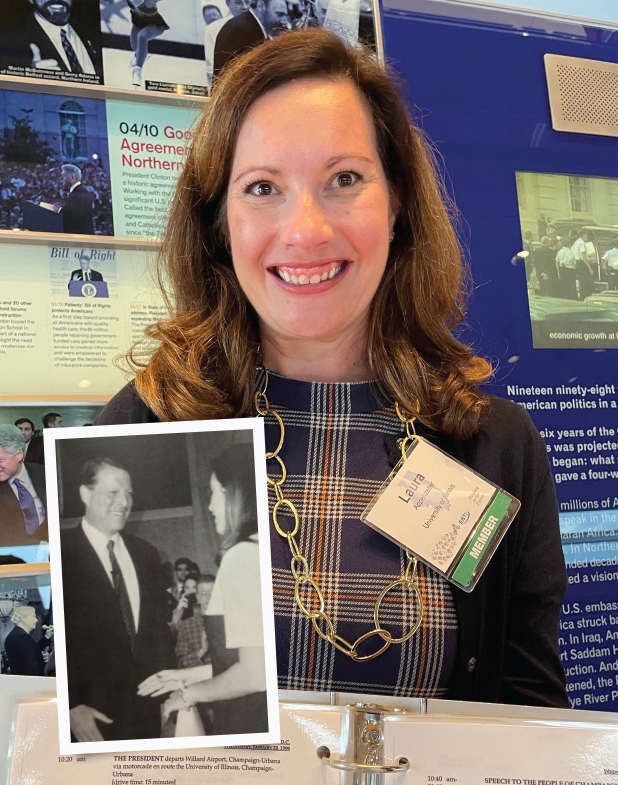
Inset: Laura Appenzeller shakes hands with Vice President Al Gore at a College of Education event, 1997; Appenzeller visits the Clinton Presidential Library, 2022. (Images courtesy of Laura Appenzeller and Illini Media)
An Introduction
Laura Appenzeller finds her plans altered, thanks to the Lewinsky scandal
Although President Clinton and his team decided not to mention the Monica Lewinsky scandal during his visit to Champaign, it still made an impact—and not only because of the inflated media presence.
Just ask Laura Appenzeller, ’99 MEDIA, executive director of the University’s Research Park, who was then president of the Illinois Student Government.
“I was scheduled to introduce President Clinton, and my parents traveled there to see me,” she says. “But that was canceled due to the Monica story breaking that week and the media attention that came to Champaign.”
Nevertheless, Appenzeller still got the opportunity to meet Clinton and Gore—in the bowels of the Assembly Hall—before they took the stage. She remembers Clinton being “engaging and impressive” in person (and tall!). But she was even more impressed by Gore, who remembered her from the previous spring, when she had introduced him before a speech at the U of I’s College of Education. “I was so shocked,” Appenzeller says. “It might have been a really good advance person [who reminded him about me], but it felt authentic, and I was excited to support him in his run for president after that.”
Twenty-five years later, Appenzeller fondly recalls the visit, despite the quashed introduction. Last year, she even traveled to the Clinton Presidential Library in Little Rock, Ark., and found her name on his official agenda for that day, the original plan in black-and-white. “It was very cool!” she says. —R.A.R.

